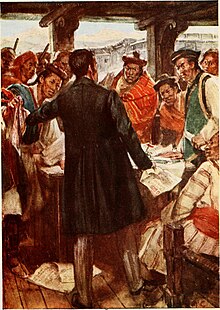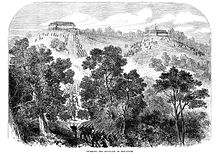Perang Bhutan
Perang Bhutan (atau Perang Bhutan) adalah perang yang terjadi antara India Britania dan Bhutan pada tahun 1864-1865.
| Perang Bhutan | |||||||||
|---|---|---|---|---|---|---|---|---|---|
| |||||||||
| Pihak terlibat | |||||||||
| Bhutan | |||||||||
| Tokoh dan pemimpin | |||||||||
|
|
Kagyud Wangchuk (1864) Tshewang Sithub (1865) | ||||||||
Inggris mengirimkan misi perdamaian ke Bhutan di awal tahun 1864, di bawah komando Ashley Eden, dan juga kegiatan ini menjadi awal dari perang saudara di sana.[1] Dzongpon (sebuah bangunan mirip benteng) yang ada di Punakha – yang memenangkan kemerdekaan – telah rusak oleh pemerintah pusat dan mengatur saingan Druk Desi ketika druk desi mencari perlindungan dari ponlop dari Paro yang kemudian terguling. Misi Inggris ditangani secara bergantian oleh sepasang rival ponlop Paro dan ponlop dari trongsa (bertindak atas nama druk desi), tetapi sayangnya Bhutan menolak perdamaian dan perjanjian persahabatan yang ditawarkan. Oleh karena itu, Inggris menyatakan perang pada bulan November 1864. Bhutan pada saat itu belum memiliki tentara yang memadai, dan hanya mengandalkan pertahanan dari benteng dzong dan senjata yang bernama matchlocks, busur serta anak panah, pedang, pisau, dan ketapel. Beberapa penjaga dzong, membawa perisai dan memakai chainmail armor, yang merupakan peralatan pasukan Inggris.


Benteng, yang dikenal pada saat itu sebagai Dewangiri, di Deothang dibongkar oleh Inggris pada tahun 1865. Inggris awalnya mengalami kekalahan yang memalukan di Deothang dan ketika mereka merebut kembali Dewangiri mereka menghancurkan banyak dalam upaya untuk mengkompensasi.
Perang Duar (1864-1865) hanya berlangsung sekitar lima bulan, meskipun beberapa medan perang dimenangi oleh pasukan Bhutan, tetapi perang yang tidak sebanding tetap membuat pihak Bhutan kalah, dan mengakibatkan mereka kehilangan daerah kedaulatannya, dan memaksa penyerahan dari wilayah-wilayah pendudukan sebelumnya oleh pihak Inggris. Di bawah syarat-syarat Perjanjian Sinchula, yang ditandatangani tanggal 11 November 1865, Bhutan menyerahkan wilayah di Assam Duars dan Bengal Duars, serta 83 km2 dari wilayah Dewangiri di tenggara Bhutan, dan kembali dengan kebijakan pajak tahunan 50.000 rupee. Perjanjian Sinchula berdiri sampai tahun 1910, ketika Bhutan dan India Inggris menandatangani Perjanjian Punakha, efektif sampai tahun 1947.
Perjanjian Sinchula
| Ditandatangani | 11 November 1865 |
|---|---|
| Lokasi | Sinchula |
| Efektif | 11 November 1865 |
| Syarat | Pelepasan kedaulan Bhutan atas kekuasaan Cooch Behar dan Duar |
| Habis tempo | 1910 |
| Penanda tangan | Pemimpin Politik untukSikkim, Herbert Bruce; Raja Bhutan Ugyen Wangchuck dan para menterinya |
| Pihak | British India; Bhutan |
| Ratifikasi | Raja Muda sekaligus Jenderal Gubernur Sir John Lawrence (British India) |
| Bahasa | English |
Di bawah ini merupakan text dari Perjanjian Sinchula.[2]
On the 11th day of November, 1865
Treaty between His Excellency the Right Honourable Sir John Lawrence, G.C.B., K.S.I., Viceroy and Governor-General of Her Britannic Majesty's possessions in the East Indies, and the one part by Lieutenant Colonel Herbert Bruce, CB, by virtue of full powers to that effect vested in him by the Viceroy and Governor – General, and on the other part by Samdojey Deb Jimpey and Themseyrensey Donai according to full powers conferred on them by the Dhum and Deb Rajahs, 1865.
ARTICLE I There shall henceforth be perpetual peace and friendship between the British Government and the Government of Bhootan.
ARTICLE II Whereas in consequence of repeated aggressions of the Bhootan Government and of the refusal of that Government to afford satisfaction for those aggressions, and for their insulting treatment of the officers sent by His Excellency the Governor-General in Council for the purpose of procuring an amicable adjustment of differences existing between the two states, the British Government has been compelled to seize by an armed force the whole of the Doars and certain Hill Posts protecting the passes into Bhootan, and whereas the Bhootan Government has now expressed its regret for past misconduct and a desire for the establishment of friendly relations with the British Government, it is hereby agreed that the whole of the tract known as the Eighteen Doars, bordering on the districts of Rungpoor, Cooch Behar, and Assam, together with the Taloo of Ambaree Fallcottah and the Hill territory on the left bank of the Teesta up to such points as may be laid down by the British Commissioner appointed for the purpose is ceded by the Bhootan Government to the British Government forever.
ARTICLE III The Bhootan Government hereby agree to surrender all British subjects, as well as subjects of the Chief of Sikkim and Cooch Behar who are now detained in Bhootan against their will, and to place no impediment in the way of the return of all or any of such persons into British territory.
ARTICLE IV In consideration of the cession by the Bhootan Government of the territories specified in Article II of this Treaty, and of the said Government having expressed its regret for past misconduct, and having hereby engaged for the future to restrain all evil disposed persons from committing crimes within British territory or the territories of the Rajahs of Sikkim and Cooch Behar and to give prompt and full redress for all such crimes which may be committed in defiance of their commands, the British Government agree to make an annual allowance to the Government of Bhootan of a sum not exceeding fifty thousand rupees (Rupees 50,000) to be paid to officers not below the rank of Jungpen, who shall be deputed by the Government of Bhootan to receive the same. And it is further hereby agreed that the payments shall be made as specified below:
On the fulfillment by the Bhootan Government of the conditions of this Treaty Twenty Five Thousand Rupees (Rupees 25,000).
On the 10th January following the 1st payment, thirty five thousand rupees (Rupees 35,000)
On the 10th January following, forty-five thousand rupees (Rupees 45,000)
On every succeeding 10th January, fifty thousand rupees (Rupees 50,000)
Lihat juga
- Hubungan luar negeri Bhutan
- Sejarah Bhutan
- Perjanjian Punakha
Referensi
- ^ "Eden, Ashley".
- ^ Singh, Nagendra; Jawaharlal Nehru University (1978). "Appendix VII – The Treaty of Sinchula". Bhutan: a Kingdom in the Himalayas : a study of the land, its people, and their government (edisi ke-2). Thomson Press Publication Division. hlm. 243. Diakses tanggal 2011-08-25.